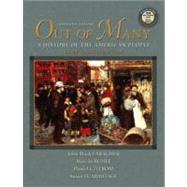
Combined Edition includes Chapters 1-31
Volume I includes Chapters 1-17
Volume II includes Chapters 17-31
(NOTE: Each chapter begins with chapter-opening outlines and key topic lists and concludes with a Chronology, Conclusion, Review Questions, Recommended Reading, Additional Bibliography, and History on the Internet.)
Preface.
Community and Diversity.
1. A Continent of Villages, to 1500.
Community and Memory: The Battle over Burials.
2. When Worlds Collide, 1492-1590.Community and Memory: The Living History of Slavery.
5. The Cultures of Colonial North America, 1700-1780.Community and Memory: The Invention of the Liberty Bell.
7. The Creation of the United States, 1776-1786.Community and Memory: In the Footsteps of Lewis and Clark.
10. The Growth of Democracy, 1824-1840.Community and Memory: Remembering the Alamo
15. The Coming Crisis, the 1850s.Community and Memory: Representing Chicago's History.
20. Commonwealth and Empire, 1870-1900.Community and Memory: Battle for the Lower East Side.
22. World War I, 1914-1920.Community and Memory: Flying the “Stars and Bars.”
29. War at Home, War Abroad, 1965-1974.Community and Memory: The World Trade Center and Ways of Remembering.
Appendix.Combined
The New copy of this book will include any supplemental materials advertised. Please check the title of the book to determine if it should include any access cards, study guides, lab manuals, CDs, etc.
The Used, Rental and eBook copies of this book are not guaranteed to include any supplemental materials. Typically, only the book itself is included. This is true even if the title states it includes any access cards, study guides, lab manuals, CDs, etc.